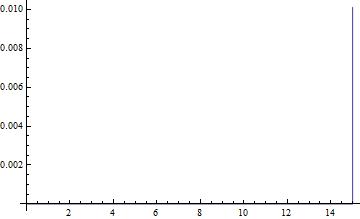The mathematical problem is shown here. I tried to solve writing the
A0 = 2.0377638272727268`;
A1 = -7.105521894545453`;
A2 = 9.234000147272726`;
A3 = -5.302489919999999`;
A4 = 1.1362478399999998`;
h0 = 45.5;
σM = 0.00592251
λ1 = 1.025;
λ2 = 1.308;
f1[y_, x_] = A1 + 2 A2 y[x] + 3 A3 y[x]^2 + 4 A4 y[x]^3
b[y_, x_] = h0^2/12 (5 A1 + 8 A2 y[x] + 9 A3 y[x]^2 + 8 A4 y[x]^3)/y[x]^6
g[y_, x_] = -(h0^2/12) (A1 + 2 A2 y[x] + 3 A3 y[x]^2 + 4 A4 y[x]^3)/y[x]^5
Sys = First@NDSolve[{
f1[y, x] + b[y, x] y'[x]^2 + g y''[x] == σM,
y[0] == λ1,
y[15] == λ2
}, y, {x, 0, 15}]
When I evaluate this code, Mathematica answers with the following errors:
Power::infy: Infinite expression 1/0.^6 encountered. >> Infinity::indet: Indeterminate expression 0. ComplexInfinity encountered. >>
Power::infy: Infinite expression 1/0.^6 encountered. >>
Infinity::indet: Indeterminate expression 0. ComplexInfinity encountered. >>
Power::infy: Infinite expression 1/0.^7 encountered. >>
General::stop: Further output of Power::infy will be suppressed during this calculation. >>
Infinity::indet: Indeterminate expression 0. ComplexInfinity encountered. >>
General::stop: Further output of Infinity::indet will be suppressed during this calculation. >>
NDSolve::ndnum: Encountered non-numerical value for a derivative at x == 0.`. >>
As suggested here (section: "StartingInitialConditions") I tried to wrote:
Sys = First@NDSolve[{
f1[y, x] + b[y, x] y'[x]^2 + g y''[x] == σM,
y[0] == λ1,
y[15] == λ2}, y, {x, 0, 15},
Method -> {"Shooting","StartingInitialConditions" -> {y[0] == λ1, y'[0] == 0.1}}]
followed by the following error:
NDSolve::ndnum: Encountered non-numerical value for a derivative at x == 0.`. >>
How can I overtake this errors? What am I doing something wrong?




